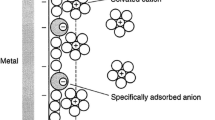Abstract
Steady-state voltammetry is easily attained in narrow cells. Here we develop an exact mathematical description of one of the simplest instances, in which a redox pair is present, but without supporting electrolyte. The Nernstian oxidation that depolarizes the anode is partnered at the nearby cathode by the converse reduction. The resulting voltammogram is sigmoidal in overall shape but, generally, no explicit analytic expression describes the current-potential relationship, or even the height of the limiting-current plateau. Such limiting currents arise either by exhaustive oxidation of one member of the redox pair at the anode or by exhaustive cathodic reduction of the other member. For a critical composition, which this study identifies, both exhaustions occur concurrently. The ionic strength plays a paramount role in unravelling the conditions during the experiment. Although no direct analytical application of this “closed” experiment suggests itself, there are implications of the theory for microgap cells and electroanalytical methods in “open” configurations, as well as separatory possibilities.







Similar content being viewed by others
References
Bond AM (1994) Past, present and future contributions of microelectrodes to analytical studies employing voltammetric detection—a review. Analyst 119:R1–R21
Chen SL, Liu YW (2014) Electrochemistry at nanometer-sized electrodes. Phys Chem Chem Phys 16:635–652
Oldham KB (2000) Steady-state voltammetry at a rotating disk electrode in the absence of supporting electrolyte. J Phys Chem B 104:4703–4706
Cooper JB, Bond AM, Oldham KB (1992) Microelectrode studies without supporting electrolyte – model and experimental comparison for singly and multiply charged ions. J Electroanal Chem 331:877–895
Myland JC, Oldham KB (1993) General theory of steady state voltammetry. J Electroanal Chem 347:49–91
Hubbard AT, Peters DG (1973) Electrochemistry in thin layers of solution. Crit Rev Anal Chem 3:201–242
Hammond JL, Gross AJ, Estrela P, Iniesta J, Green SJ, Winlove CP, Winyard PG, Benjamin N, Marken F (2014) Cysteine-cystine redox cycling in a gold-gold dual-plate generator-collector microtrench sensor. Anal Chem 86:6748–6752
Gross AJ, Marken F (2014) Boron-doped diamond dual-plate microtrench electrode for generator-collector chloride/chlorine sensing. Electrochem Commun 46:120–123
Mathwig K, Lemay SG (2013) Mass transport in electrochemical nanogap sensors. Electrochim Acta 112:943–949
Barnes EO, Lewis GEM, Dale SEC, Marken F, Compton RG (2012) Generator-collector double electrode systems: a review. Analyst 137:1068–1081
Singh PS, Kaetelhoen E, Mathwig K, Wolfrum B, Lemay SG (2012) Stochasticity in single-molecule nanoelectrochemistry: origins, consequences, and solutions. ACS Nano 6:9662–9671
Lemay SG, Kang S, Mathwig K, Singh PS (2013) Single-molecule electrochemistry: present status and outlook. Acc Chem Res 46:369–377
Buck RP (1973) Steady-state space charge effects in symmetric cells with concentration-polarized electrodes. J.Electroanal.Chem. 46:1–23
Hyk W, Stojek Z (2013) Thin and ultra-thin layer dual electrode electrochemistry: theory of steady-state voltammetry without supporting electrolyte. Electrochem Commun 34:192–195
Oldham KB, Feldberg SW (1999) The principle of unchanging total concentration and its implications for modeling unsupported transient voltammetry. J Phys Chem B 103:1699–1704
Oldham KB, Myland JC, Bond AM (2004) Electrochemical science and technology. Wiley, Chichester, p. 161
Wolfram S (1999) The Mathematica book 4e. Cambridge University Press, New York
Rassaei L, Mathwig K, Kang S, Heering HA, Lemay SG (2014) Integrated biodetection in a nanofluidic device. ACS Nano 8:8278–8284
Gross AJ, Marken F (2015) ITO-ITO dual-plate microgap electrodes: E and EC′ generator-collector processes. Electroanalysis 27:1035–1042
Author information
Authors and Affiliations
Corresponding author
Ethics declarations
Conflict of interest
The authors deny any financial conflict of interest in disseminating this unfunded research.
Additional information
For the special issue dedicated to the 70th birthday of George Inzelt.
Rights and permissions
About this article
Cite this article
Oldham, K.B., Marken, F. & Myland, J.C. Theory of unsupported, steady-state, Nernstian, three-ion, twin-electrode, voltammetry: the special case of dual concentration polarization. J Solid State Electrochem 20, 3083–3095 (2016). https://doi.org/10.1007/s10008-015-3113-3
Received:
Revised:
Accepted:
Published:
Issue Date:
DOI: https://doi.org/10.1007/s10008-015-3113-3




